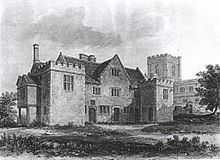Edington Priory

Edington Priory in Wiltshire, England, was founded by William Edington, the bishop of Winchester, in 1332 in his home village of Edington. The priory church was built between 1352 and 1361.[1]
History
What was originally a college for priests later became a monastery for Augustinian canons. The Catholic Encyclopedia claims that it was granted by Edward the Black Prince to the Brothers of Penitence.[2]
The first rector, brought from Ashridge Priory, was John de Aylesbury, the last John Ryve. Edward VI granted the property to William Paulet, Baron St John; by the 19th century it belonged to the Watson-Taylor family.[3]
During Jack Cade's rebellion in 1450, William Ayscough, Bishop of Salisbury and confessor to Henry VI, was forced to flee Salisbury. Seeking refuge in the church at Edington, he was discovered on 29 June, dragged from the high altar during mass and murdered in the fields outside the church.
The church still stands today, a good example of the transition between the decorated and perpendicular style of church-building. It contains the burial monuments of several local notables, including tombs removed from St Giles at Imber during the early 1950s - following the evacuation of the village in 1943.
Every August a festival of church music is held there.[4][5]
See also
-

The Priory in 2008
-

The Priory in 2008
-
Another view
-

Pews in the nave
-

Roof of the nave
References
- ↑ Edington Priory, Wiltshire, Nash Ford Publishing 2005
- ↑ who (says Leland) "had a great favour to the Bones-homes beyond the Se", from Boni Homines - Catholic Encyclopedia article
- ↑ Little, the Friars of the Sack, in English Historical Review, 1894, 33, 121, cited in Boni Homines - Catholic Encyclopedia article
- ↑ The festival
- ↑ The festival on BBC
External links
| Wikimedia Commons has media related to Edington Priory. |
